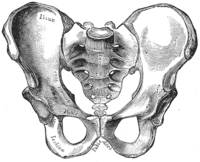
Photo from wikipedia
The purpose of this study was to identify the instability of the trunk and the pelvis of subjects who were standing on differently angled ramps under conditions in which the… Click to show full abstract
The purpose of this study was to identify the instability of the trunk and the pelvis of subjects who were standing on differently angled ramps under conditions in which the ramps were crossed. Changes in the trunk and the pelvis while each subject was standing on one leg in the direction of the cross ramps at four angles (0°, 5°, 10°, and 15°) were measured. To identify instability, the trunk inclination, trunk imbalance, pelvic position, pelvic rotation, and pelvic torsion of 20 healthy male subjects were measured. The measurement was conducted using a three-dimensional spinal diagnostic imaging system (Back Mapper). According to the results of the measurement, trunk imbalance, pelvic position, pelvic rotation, and pelvic torsion differed between the medial and lateral ramps and with different ramp angles. This study’s results suggested that different mediolateral ramp conditions altered the pelvic and trunk alignment. With the 15° ramp, the anterior tilt and lateral tilt of the pelvis increased regardless of ramp direction. The 10° ramp condition altered the pelvic rotation to the contralateral side. In addition, the lateral trunk tilt was elevated with the lateral down foot condition.
Journal Title: Journal of Exercise Rehabilitation
Year Published: 2017
Link to full text (if available)
Share on Social Media: Sign Up to like & get
recommendations!